Inserting Citations Using Microsoft Word
When you install Zotero on your computer, it should automatically install the Microsoft Word Add-in which will add a Zotero Tab to the ribbon in Microsoft Word. If you do not see the Zotero tab, you may need to install the Add-in manually. To do this, open Zotero and go to Edit > Preferences, then click on the “Cite” icon. Switch from the Styles tab to the Word Processors tab, and you should see a button labeled “Install Microsoft Word Add-in.” Use this to install the Add-in.

Once you see the Zotero tab in Microsoft Word, you are ready to use Zotero to insert citations in your work. Remember: The Zotero app must be running in order for Microsoft Word to communicate with and insert citations from Zotero.
To insert a citation into your work, ensure that the cursor is placed where you want the footnote to appear in your text and click the “Add/Edit Citation” button in the Zotero tab.
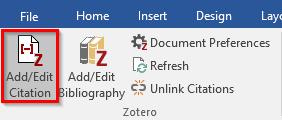
The first time you add a citation to your document, a preferences screen will appear, asking you to select the style you wish to use. Select the CTSFW Turabian style and click “OK.” If you want to change styles later, you can do so by clicking “Document Preferences” in the Zotero tab. After you have clicked the “Add/Edit Citation” button, a red Zotero search bar will appear. Search for the source you will be citing by typing any identifying information for the source (e.g., author’s name, title, year, etc.). A list of possible matches will automatically appear and be refined as you continue to type. Works you have already used in this document will appear at the top of the list. When you find the source you want, select it from the list.
Hint: Typing the word “ibid” in the search bar will automatically bring up the last source you cited.

To add page numbers and other refinements to your citation, click the source name that appears in the search bar. A menu will appear where you can add a page or page range, prefix text (e.g., “For more examples see . . .”), or suffix text (e.g., emphasis added). All revisions to your citation should be made here. If you type directly into your citation or edit it in the document, it will break the link to Zotero and subsequent references to the same text will not appear correctly.
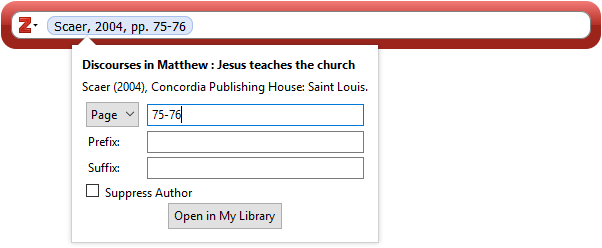
When you are finished adding page numbers and any other information to your citation, press enter to dismiss the menu and return to the search bar. If you wish to add another citation in the same footnote, follow the same procedure to search for the next citation. If you are done adding citations, press the enter key again to insert the citation in your text.
Note: If you need to edit the page numbers, prefix, or suffix in your citation, place the cursor in the footnote text and click the “Add/Edit Citation” button in the Zotero tab. This will allow you to edit your footnote without breaking the link to Zotero. If any other information in your citation needs to be updated, such as the author, title, or publication information, return to the Zotero app and make the changes there. To see these changes reflected in your document, click the “Refresh” button in the Zotero tab.
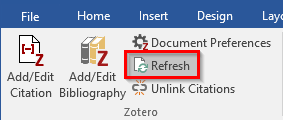
Inserting Citations Using Google Docs
If you have the Zotero Connector browser extension installed, it will add a Zotero menu and a Zotero button to Google Docs.

The Zotero menu contains all the same items as the Zotero tab in Microsoft Word pictured above, and functions identically. The Zotero button in the Google Docs toolbar can be used to quickly add citations to your document. To edit a citation in your document, place the cursor in the footnote text and an option will appear to “Edit with Zotero.” As in Microsoft Word, you will want to edit your footnotes with Zotero to avoid breaking the connection between your footnote and Zotero.
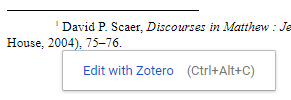
Aside from these notes, Zotero functions the same in Google Docs as it does in Microsoft Word.
Creating a Bibliography with Zotero
An auto-generated bibliography containing all the resources you cited in your work can be inserted into your text by clicking “Add/Edit Bibliography” in the Zotero Tab in Microsoft Word, or the Zotero menu in Google Docs. Your bibliography will be created and inserted wherever you have placed your cursor, so make sure you have your cursor where you want your first bibliography entry to begin.
If you add more references to your paper later, the bibliography will automatically update to include those additions. If you need to make changes to your bibliographic records, make the changes in the Zotero app, and use the “Refresh” button to see these changes in your document.
If you need to make changes to your bibliography, such as inserting headings for bibliography subsections (e.g., primary sources, secondary sources), or adding references that cannot be handled by Zotero (e.g., Luther’s Works), it is best to save this until the very end. Make a backup copy of your document, then click “Unlink Citations” to disconnect your document from Zotero and convert all citations and the bibliography to regular text.
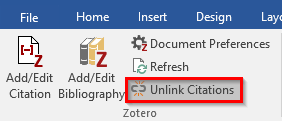
After this, you will no longer be able to use Zotero to edit your citations or bibliography. You may then make any adjustments to your bibliography text without Zotero reverting them when it refreshes.



